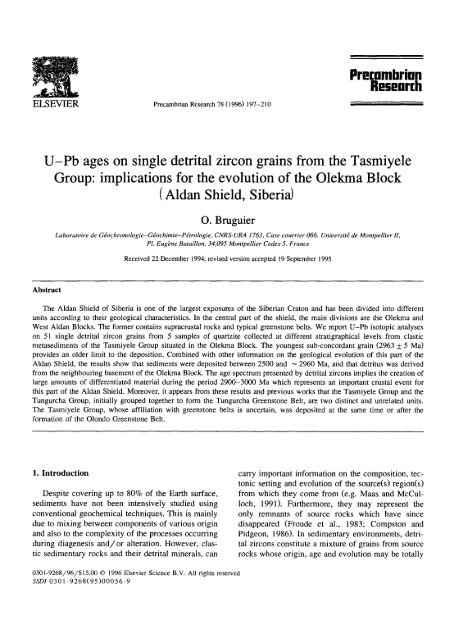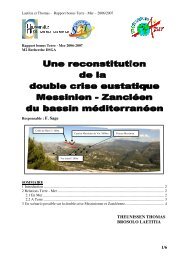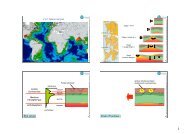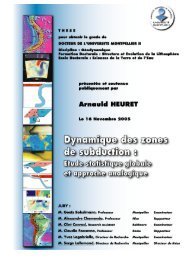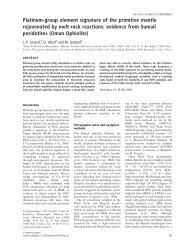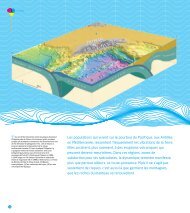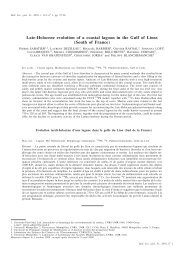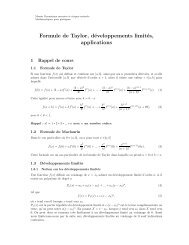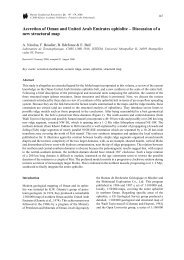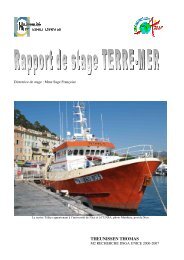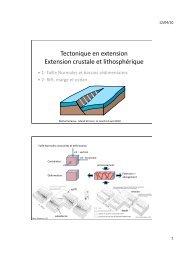Géochronologie U-Pb par ablation laser et ICP-MS (LA-ICP-MS ...
Géochronologie U-Pb par ablation laser et ICP-MS (LA-ICP-MS ...
Géochronologie U-Pb par ablation laser et ICP-MS (LA-ICP-MS ...
You also want an ePaper? Increase the reach of your titles
YUMPU automatically turns print PDFs into web optimized ePapers that Google loves.
ELSEVIER PrecambfianResearch 78 (1996) 197-210<br />
Pre[nmbrinn<br />
Resenrth<br />
U-<strong>Pb</strong> ages on single d<strong>et</strong>rital zircon grains from the Tasmiyele<br />
Group: implications for the evolution of the Olekma Block<br />
(Aldan Shield, Siberia)<br />
O. Bruguier<br />
Laboratoire de G£ochronologie-Gdochimie-P£trologie, CNRS-URA 1763, Case courrier 066, Universit£ de Montpellier 11,<br />
PI. Eugene Bataillon, 34,095 Montpellier Cedex 5, France<br />
Received 22 December 1994; revised version accepted 19 September 1995<br />
Abstract<br />
The Aldan Shield of Siberia is one of the largest exposures of the Siberian Craton and has been divided into different<br />
units according to their geological characteristics. In the central <strong>par</strong>t of the shield, the main divisions are the Olekma and<br />
West Aldan Blocks. The former contains supracrustal rocks and typical greenstone belts. We report U-<strong>Pb</strong> isotopic analyses<br />
on 51 single d<strong>et</strong>rital zircon grains from 5 samples of quartzite collected at different stratigraphical levels from clastic<br />
m<strong>et</strong>asediments of the Tasmiyele Group situated in the Olekma Block. The youngest sub-concordant grain (2963 ___ 5 Ma)<br />
provides an older limit to the deposition. Combined with other information on the geological evolution of this <strong>par</strong>t of the<br />
Aldan Shield, the results show that sediments were deposited b<strong>et</strong>ween 2500 and ~ 2960 Ma, and that d<strong>et</strong>ritus was derived<br />
from the neighbouring basement of the Olekma Block. The age spectrum presented by d<strong>et</strong>rital zircons implies the creation of<br />
large amounts of differentiated material during the period 2900-3000 Ma which represents an important crustal event for<br />
this <strong>par</strong>t of the Aldan Shield. Moreover, it appears from these results and previous works that the Tasmiyele Group and the<br />
Tungurcha Group, initially grouped tog<strong>et</strong>her to form the Tungurcha Greenstone Belt, are two distinct and unrelated units.<br />
The Tasmiyele Group, whose affiliation with greenstone belts is uncertain, was deposited at the same time or after the<br />
formation of the Olondo Greenstone Belt.<br />
1. Introduction<br />
Despite covering up to 80% of the Earth surface,<br />
sediments have not been intensively studied using<br />
conventional geochemical techniques. This is mainly<br />
due to mixing b<strong>et</strong>ween components of various origin<br />
and also to the complexity of the processes occurring<br />
during diagenesis and/or alteration. However, clastic<br />
sedimentary rocks and their d<strong>et</strong>rital minerals, can<br />
carry important information on the composition, tectonic<br />
s<strong>et</strong>ting and evolution of the source(s) region(s)<br />
from which they come from (e.g. Maas and McCulloch,<br />
1991). Furthermore, they may represent the<br />
only remnants of source rocks which have since<br />
disappeared (Froude <strong>et</strong> al., 1983; Compston and<br />
Pidgeon, 1986). In sedimentary environments, d<strong>et</strong>rital<br />
zircons constitute a mixture of grains from source<br />
rocks whose origin, age and evolution may be totally<br />
0301-9268/96/$15.00 © 1996 Elsevier Science B.V. All rights reserved<br />
SSDI 0301-9268(95)00056-9


